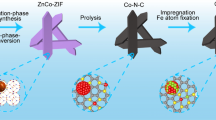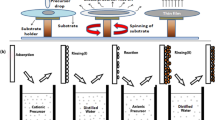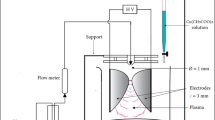Abstract
Tungsten oxide (WO3) is a well-known transition metal oxide that demonstrates stability and non-toxicity in its nanoparticle form. Because of its facile and cost-effective synthesis method, it is a promising candidate for several applications like electrochromic devices, photo catalysts and gas sensors. In the present work, WO3 nanoparticles were synthesized through a one-step hydrothermal process. Subsequently, the pure WO3 sample underwent do** with different materials, including Cr+ 3, Co+ 2, Ag+ 1, Hg+ 1 and Pb+ 4. The crystallographic properties and phase transitions of the crystalline substances were demonstrated by the structural characterisation of all the as-synthesised materials using the X-ray diffraction technique. The optical properties were explored by UV-visible spectroscopy, revealing the energy band gap from 2.53 eV to 3.75 eV. Field Emission Scanning electron microscopy (FESEM) images depicted the morphological features of the material. The pure WO3 exhibited a 2D nanosheet structure, while the doped materials displayed morphologies ranging from nanosheets or nanorods to polyhedral sheets. Microstructural analysis by TEM revealed particle size for all samples along with fringes and SAED pattern confirming the presence of respective planes. The electrochemical properties of the synthesized samples were investigated using Electrochemical Impedance Spectroscopy (EIS) and Cyclic Voltammetry (CV) techniques. This research delves into exploring the electrochemical sensing potential of tungsten oxide doped with chromium, cobalt, silver, mercury, and lead as thin layer working electrodes, driven by the pressing need for advancements in sensing technologies. Through a comprehensive investigation of their electrochemical and optical characteristics, this study aims to discern their suitability for sensing applications, providing insights crucial for future sensor design and synthesis.








Similar content being viewed by others
Data availability
All the data is presented in the manuscript and supplementary file.
References
F. Lv et al., Iridium–Tungsten Alloy nanodendrites as pH-Universal Water-Splitting electrocatalysts. ACS Cent. Sci. 4(9), 1244–1252 (Sep. 2018). https://doi.org/10.1021/acscentsci.8b00426
R. Azimirad, O. Akhavan, A.Z. Moshfegh, Simple Method to Synthesize NaxWO3 Nanorods and Nanobelts, The Journal of Physical Chemistry C, vol. 113, no. 30, pp. 13098–13102, Jul. 2009, https://doi.org/10.1021/jp902189h
C.C. Mardare, A.W. Hassel, Review on the versatility of Tungsten Oxide Coatings. Phys. Status Solidi (A) Appl. Mater. Sci. 216(12) (Jun. 2019). https://doi.org/10.1002/pssa.201900047
J. Wang, A. Han, S. Jaenicke, G.-K. Chuah, Chapter 6 - advances in Sorbents and photocatalytic materials for Water Remediation, in in New and Future Developments in Catalysis, ed. by S.L. Suib (Elsevier, Amsterdam, 2013), pp. 127–153. https://doi.org/10.1016/B978-0-444-53870-3.00006-X
A.Z. Moshfegh, R. Azimirad, O. Akhavan, Optical properties and surface morphology of evaporated (WO3)1 – x–(Fe2O3)x thin films. Thin Solid Films. 484(1), 124–131 (2005). https://doi.org/10.1016/j.tsf.2005.02.019
D. Ma, T. Li, Z. Xu, L. Wang, J. Wang, Electrochromic devices based on tungsten oxide films with honeycomb-like nanostructures and nanoribbons array. Sol. Energy Mater. Sol. Cells. 177, 51–56 (2018). https://doi.org/10.1016/j.solmat.2017.06.009
M. Gies, F. Michel, C. Lupó, D. Schlettwein, M. Becker, A. Polity, Electrochromic switching of tungsten oxide films grown by reactive ion-beam sputter deposition. J. Mater. Sci. 56(1), 615–628 (2021). https://doi.org/10.1007/s10853-020-05321-y
R. Azimirad, O. Akhavan, A.Z. Moshfegh, Influence of Coloring Voltage and Thickness on Electrochromical Properties of e-beam Evaporated WO3 Thin Films, J Electrochem Soc, vol. 153, no. 2, p. E11, Dec. 2005, https://doi.org/10.1149/1.2137653
A. Hoel, L.F. Reyes, P. Heszler, V. Lantto, C.G. Granqvist, Nanomaterials for environmental applications: novel WO3-based gas sensors made by advanced gas deposition, Current Applied Physics, vol. 4, no. 5, pp. 547–553, Aug. 2004, https://doi.org/10.1016/J.CAP.2004.01.016
J.P. Kollender, A.I. Mardare, A.W. Hassel, Effect of different cobalt concentrations on Tungsten Trioxide Photoelectrodes for Use in Solar Water Oxidation. J. Electrochem. Soc. 162(4), H187–H193 (2015). https://doi.org/10.1149/2.0711503jes
A.W. Hassel et al., Nanomechanics of single crystalline tungsten nanowires, J Nanomater, vol. 2008, no. 1, 2008, https://doi.org/10.1155/2008/638947
B. Ahmed et al., Well-controlled in-situ growth of 2D WO3 rectangular sheets on reduced graphene oxide with strong photocatalytic and antibacterial properties. J. Hazard. Mater. 347, 266–278 (2018). https://doi.org/10.1016/j.jhazmat.2017.12.069
O. Akhavan, M. Choobtashani, E. Ghaderi, Protein degradation and RNA efflux of viruses photocatalyzed by graphene–tungsten oxide composite under visible light irradiation. J. Phys. Chem. C 116(17), 9653–9659 (May 2012). https://doi.org/10.1021/jp301707m
A. Esfandiar, A. Irajizad, O. Akhavan, S. Ghasemi, M.R. Gholami, Pd–WO3/reduced graphene oxide hierarchical nanostructures as efficient hydrogen gas sensors. Int. J. Hydrogen Energy. 39, 8169–8179 (2014). https://doi.org/10.1016/j.ijhydene.2014.03.117
S.J. Lee et al., Apr., VO2/WO3-Based Hybrid Smart Windows with Thermochromic and Electrochromic Properties, ACS Sustain Chem Eng, vol. 7, no. 7, pp. 7111–7117, 2019, https://doi.org/10.1021/acssuschemeng.9b00052
R. Azimirad, A. Khademi, O. Akhavan, A.Z. Moshfegh, Growth of Na0.3WO3 nanorods for the field emission application. J. Phys. D Appl. Phys. 42, 205405 (Sep. 2009). https://doi.org/10.1088/0022-3727/42/20/205405
M. Arslan, Y.E. Firat, S.R. Tokgöz, A. Peksoz, Fast electrochromic response and high coloration efficiency of Al-doped WO3 thin films for smart window applications, Ceram Int, vol. 47, no. 23, pp. 32570–32578, Dec. 2021, https://doi.org/10.1016/j.ceramint.2021.08.152
Y. Yin, C. Lan, H. Guo, C. Li, Reactive sputter deposition of WO3/Ag/WO3 Film for Indium Tin Oxide (ITO)-Free Electrochromic devices. ACS Appl. Mater. Interfaces. 8(6), 3861–3867 (Feb. 2016). https://doi.org/10.1021/acsami.5b10665
Z. **e et al., Fast fabrication of a WO 3·2H 2O thin film with improved electrochromic properties. J. Mater. Chem. 22(37), 19904–19910 (Oct. 2012). https://doi.org/10.1039/c2jm33622g
R. Zhang, F. Ning, S. Xu, L. Zhou, M. Shao, M. Wei, Oxygen vacancy engineering of WO3 toward largely enhanced photoelectrochemical water splitting. Electrochim. Acta. 274, 217–223 (2018). https://doi.org/10.1016/j.electacta.2018.04.109
X. Chang, S. Sun, X. Xu, Z. Li, Synthesis of transition metal-doped tungsten oxide nanostructures and their optical properties. Mater. Lett. 65(11), 1710–1712 (Jun. 2011). https://doi.org/10.1016/j.matlet.2011.02.060
G. Adilakshmi, A. Sivasankar Reddy, P. Sreedhara Reddy, C. Seshendra Reddy, Electron Beam evaporated nanostructure WO3 films for gas sensor application. Mater. Sci. Engineering: B 273 (Nov. 2021). https://doi.org/10.1016/j.mseb.2021.115421
M. Deepa, T.K. Saxena, D.P. Singh, K.N. Sood, S.A. Agnihotry, Spin coated versus dip coated electrochromic tungsten oxide films: Structure, morphology, optical and electrochemical properties, Electrochim Acta, vol. 51, no. 10, pp. 1974–1989, Feb. 2006, https://doi.org/10.1016/j.electacta.2005.06.027
D. Sánchez-Martínez, A. Martínez-De La, Cruz, E. López-Cuéllar, Synthesis of WO3 nanoparticles by citric acid-assisted precipitation and evaluation of their photocatalytic properties. Mater. Res. Bull. 48(2), 691–697 (Feb. 2013). https://doi.org/10.1016/J.MATERRESBULL.2012.11.024
I. Jiménez, J. Arbiol, A. Cornet, J.R. Morante, Structural and gas-sensing properties of WO3 nanocrystalline powders obtained by a sol-gel method from tungstic acid. IEEE Sens. J. 2(4), 329–334 (2002). https://doi.org/10.1109/JSEN.2002.803747
L. Santos et al., Synthesis of WO3 nanoparticles for biosensing applications. Sens. Actuators B Chem. 223, 186–194 (Feb. 2016). https://doi.org/10.1016/j.snb.2015.09.046
M. Arshad et al., Synthesis and characterization of Zn doped WO3 nanoparticles: Photocatalytic, antifungal and antibacterial activities evaluation. Mater. Res. Express. 7(1) (2020). https://doi.org/10.1088/2053-1591/ab6380
F. Ghasempour, R. Azimirad, A. Amini, O. Akhavan, Visible light photoinactivation of bacteria by tungsten oxide nanostructures formed on a tungsten foil. Appl. Surf. Sci. 338, 55–60 (2015). https://doi.org/10.1016/j.apsusc.2015.01.217
S. Mohammed Harshulkhan, K. Janaki, G. Velraj, R. Sakthi Ganapthy, M. Nagarajan, Effect of Ag do** on structural, optical and photocatalytic activity of tungsten oxide (WO3) nanoparticles. J. Mater. Sci.: Mater. Electron. 27(5), 4744–4751 (May 2016). https://doi.org/10.1007/S10854-016-4354-3/FIGURES/9
D. Paluselli, B. Marsen, E.L. Miller, R.E. Rocheleau, Nitrogen do** of reactively sputtered tungsten oxide films. Electrochem. Solid-State Lett. 8(11) (2005). https://doi.org/10.1149/1.2042629
A. Tacca et al., Photoanodes based on Nanostructured WO3 for Water Splitting. ChemPhysChem. 13(12), 3025–3034 (2012). https://doi.org/10.1002/cphc.201200069
S. Adhikari, K. Sarath Chandra, D.-H. Kim, G. Madras, D. Sarkar, Understanding the morphological effects of WO3 photocatalysts for the degradation of organic pollutants. Adv. Powder Technol. 29, 1591–1600 (2018). https://doi.org/10.1016/j.apt.2018.03.024
N. Naseri, R. Azimirad, O. Akhavan, A.Z. Moshfegh, Improved electrochromical properties of sol–gel WO3 thin films by do** gold nanocrystals, Thin Solid Films, vol. 518, no. 8, pp. 2250–2257, 2010, https://doi.org/10.1016/j.tsf.2009.08.001
L. Santos et al., Synthesis of WO3 nanoparticles for biosensing applications. Sens. Actuators B Chem. 223, 186–194 (2016). https://doi.org/10.1016/j.snb.2015.09.046
X. Mu et al., High efficiency organic/silicon hybrid solar cells with do**-free selective emitter structure induced by a WO3 thin interlayer. Nano Energy. 16, 54–61 (2015). https://doi.org/10.1016/j.nanoen.2015.06.015
S. Ansari, M.S. Ansari, S.P. Satsangee, R. Jain, WO3 decorated graphene nanocomposite based electrochemical sensor: a prospect for the detection of anti-anginal drug. Anal. Chim. Acta. 1046, 99–109 (2019). https://doi.org/10.1016/j.aca.2018.09.028
A.C. Anithaa, N. Lavanya, K. Asokan, C. Sekar, WO3 nanoparticles based direct electrochemical dopamine sensor in the presence of ascorbic acid. Electrochim. Acta. 167, 294–302 (Jun. 2015). https://doi.org/10.1016/j.electacta.2015.03.160
M.A.M. Khan, S. Kumar, T. Ahamad, A.N. Alhazaa, Enhancement of photocatalytic and electrochemical properties of hydrothermally synthesized WO3 nanoparticles via ag loading. J. Alloys Compd. 743, 485–493 (Apr. 2018). https://doi.org/10.1016/j.jallcom.2018.01.343
H.A. Elbatal, A.M. Abdelghany, F.H. Elbatal, F.M. Ezzeldin, Gamma rays interactions with WO 3-doped lead borate glasses. Mater. Chem. Phys. 134(1), 542–548 (May 2012). https://doi.org/10.1016/j.matchemphys.2012.03.032
F. Li et al., Synthesis and characterization of Cr-doped WO3 nanofibers for conductometric sensors with high xylene sensitivity. Sens. Actuators B Chem. 265, 355–364 (Jul. 2018). https://doi.org/10.1016/j.snb.2018.03.054
V. Hariharan, B. Gnanavel, V. Aroulmoji, R. Sathiyapriya, K. Prabakaran, C. Sekar, Super conducting applications. Int. J. Adv. Sci. Eng. 4(4), 698–2349 (2018). https://doi.org/10.29294/IJASE.4.4.2018.698-706ï
P. Shreya; Phogat, R. Jha, S. Singh, Elevated refractive index of MoS2 amorphous nanoparticles with a Reduced Band Gap Applicable for Optoelectronics, in Recent Advances in Mechanical Engineering. STAAAR 2022 Lecture Notes in Mechanical Engineering, ed. by B. Sethuraman, P. Jain, M. Gupta (Springer, Singapore, 2023), pp. 431–439. https://doi.org/10.1007/978-981-99-2349-6_39
S.B. Upadhyay, R.K. Mishra, P.P. Sahay, Cr-doped WO3 nanosheets: Structural, optical and formaldehyde sensing properties. Ceram. Int. 42, 15301–15310 (Nov. 2016). https://doi.org/10.1016/J.CERAMINT.2016.06.170
P. Shreya; Phogat, R. Jha, S. Singh, Microwave-synthesized γ-WO3 nanorods exhibiting high current density and diffusion characteristics. Transition Met. Chem. 48, 167–183 (2023). https://doi.org/10.1007/s11243-023-00533-y
D. Kumari, S. Sharma, P. Phogat, D. Dipti, S. Singh, R. Jha, Enhanced electrochemical behavior of C@CdS Core-Shell heterostructures. Mater. Sci. Engineering: B 301, 117212 (2024). https://doi.org/10.1016/j.mseb.2024.117212
T. Kumar, P. Shreya, V. Phogat, Sahgal, R. Jha, Surfactant-mediated modulation of morphology and charge transfer dynamics in tungsten oxide nanoparticles. Phys. Scripta 2023, 98 (8) 085936. https://doi.org/10.1088/1402-4896/ace566
P. Phogat, R. Shreya, Jha, S. Singh, Optical and microstructural study of wide Band Gap ZnO@ZnS Core–Shell nanorods to be used as solar cell applications, in Recent Advances in Mechanical Engineering. STAAAR 2022 Lecture Notes in Mechanical Engineering, ed. by B. Sethuraman, P. Jain, M. Gupta (Springer, Singapore, 2023), pp. 419–429. https://doi.org/10.1007/978-981-99-2349-6_38
P. Phogat, R. Shreya, S. Jha, Singh, Electrochemical Analysis of thermally treated two dimensional zinc sulphide hexagonal nano-sheets with reduced band gap. Phys. Scr. 98(12), 125962 (2023). https://doi.org/10.1088/1402-4896/ad0d93
P. Van Tong, N.D. Hoa, N. Van Duy, D.T.T. Le, N. Van Hieu, Enhancement of gas-sensing characteristics of hydrothermally synthesized WO3 nanorods by surface decoration with pd nanoparticles. Sens. Actuators B Chem. 223, 453–460 (Feb. 2016). https://doi.org/10.1016/J.SNB.2015.09.108
S.M. Kanan, C.P. Tripp, Synthesis, FTIR studies and sensor properties of WO3 powders. Curr. Opin. Solid State Mater. Sci. 11, 1–2 (Feb. 2007). https://doi.org/10.1016/j.cossms.2007.11.001
IR Spectrum Table. Accessed, Jan. 11, 2024. [Online]. Available: https://www.sigmaaldrich.com/IN/en/technical-documents/technical-article/analytical-chemistry/photometry-and-reflectometry/ir-spectrum-table
M. Deepa, N. Sharma, P. Varshney, S.P. Varma, S.A. Agnihotry, FTIR investigations of solid precursor materials for sol-gel deposition of WO 3 based electrochromic films, 2000
Y. Li et al., Mar., Identification of Cobalt Oxides with Raman Scattering and Fourier Transform Infrared Spectroscopy, Journal of Physical Chemistry C, vol. 120, no. 8, pp. 4511–4516, 2016, https://doi.org/10.1021/acs.jpcc.5b11185
O. Gharbi, M.T.T. Tran, B. Tribollet, M. Turmine, V. Vivier, Revisiting cyclic voltammetry and electrochemical impedance spectroscopy analysis for capacitance measurements. Electrochim. Acta. 343 (May 2020). https://doi.org/10.1016/j.electacta.2020.136109
A. Elzwawy, A.M. Mansour, H.S. Magar, A.B.A. Hammad, R.Y.A. Hassan, A.M. El Nahrawy, Exploring the structural and electrochemical sensing of wide bandgap calcium phosphate/CuxFe3-xO4 core-shell nanoceramics for H2O2 detection. Mater. Today Commun. 33 (Dec. 2022). https://doi.org/10.1016/j.mtcomm.2022.104574
A.B. Abou Hammad et al., Detection of 3,4-diaminotoluene based on Sr0.3Pb0.7TiO3/CoFe2O4 core/shell nanocomposite: Via an electrochemical approach. New J. Chem. 44, 7941–7953 (May 2020). https://doi.org/10.1039/d0nj01074j
Acknowledgements
Author’s would like to thank vice chancellor of NSUT, Prof. Anand Srivastava for financial support.
Author information
Authors and Affiliations
Contributions
Tamanna **dal: Conceptualization, Writing - original draft, Peeyush Phogat: Formal analysis Writing-review and editing. Shreya: Formal analysis and software. Ranjana Jha: Supervision. Sukhvir Singh: Supervision.
Corresponding author
Ethics declarations
Ethical approval
All the authors have worked in accordance with ethical standard and approved by Netaji Subhas University of Technology.
Conflict of interest
No conflicts of interest exist among the authors.
Additional information
Publisher’s Note
Springer Nature remains neutral with regard to jurisdictional claims in published maps and institutional affiliations.
Electronic supplementary material
Below is the link to the electronic supplementary material.
Rights and permissions
Springer Nature or its licensor (e.g. a society or other partner) holds exclusive rights to this article under a publishing agreement with the author(s) or other rightsholder(s); author self-archiving of the accepted manuscript version of this article is solely governed by the terms of such publishing agreement and applicable law.
About this article
Cite this article
**dal, T., Phogat, P., Shreya et al. Electrochemical and optical comparison of Cr3+, Co2+, Ag1+, Hg1+ and Pb4+ doped WO3 as a thin layer working electrode for electrochemical sensing. Appl. Phys. A 130, 512 (2024). https://doi.org/10.1007/s00339-024-07666-6
Received:
Accepted:
Published:
DOI: https://doi.org/10.1007/s00339-024-07666-6




